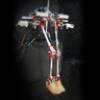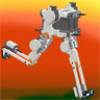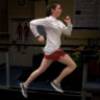Biped Robots

Physical models raise questions that computer-models do not pose. In this project experimental biomechanical findings, neural control concepts and computational model predictions are biomimetically translated into robots to proof concepts, raise new questions and to better understand human leg function.
Involved People: Christophe Maufroy, Moritz Maus, Martin Grimmer, Daniel Maykranz, André Seyfarth
Previous people: James Andrew Smith, Fumiya Iida, Poramate Manoonpong, Daniel Renjewski
Subjects

JenaWalker is a series of bipedal robots having three-segmented legs. The segments are connected via mono- and biarticular springs or elastic tendons. The JenaWalker is basically a testbed for investigating passive structures and neural control required for human-like walking on elastic legs.

RunBot is bipedal robot developed at the Bernstein Center for Computational Neuroscience Göttingen. It is based on the principle of passive dynamic walkers having extended and therewith stiff legs during stance phase. The trunk is kept upright using a neural network and novel learning strategies.

The fundamental model for investigating bipedal gaits is the spring-mass model. In this template the legs are represented as massless springs and the body is reduced to a point mass. The spring-mass model is able to show the leg dynamics in both, walking and running.

Numerous biomechanical variables are supplied by a number of experiments on human walking and running. These include ground reaction forces, motion analysis, and surface EMG, which are basis for a broad variety of analysis.
Jena Walker
Jena Walker II
The JenaWalkerII robot was built to investigate the role of elastic structures in the leg during human locomotion. By introducing simple sinusoidal hip oscillations (DC motors), walking, hopping and running movements can be observed. No sensory feedback was required to stabilize locomotion.
Partners


Publications
- Renjewski D, Seyfarth A, Manoonpong P, Woergoetter F. From Biomechanical Concepts Towards Fast And Robust Robots. Advances in Mobile Robotics: Proc. of 11th CLAWAR, Marques L, Almeida A, Tokhi MO, Virk GS (Eds.), World Scientific: 630-637, 2008.
- Seyfarth A, Tausch R, Stelzer M, Iida F, Karguth A, von Stryk O. Towards Bipedal Running as a Natural Result of Optimizing Walking Speed for Passively Compliant Three-Segmented Legs. International Journal of Robotics Research, (in press).
- Iida F, Minekawa Y, Rummel J, Seyfarth A. Toward a human-like biped robot with compliant legs. Robotics and Autonomous Systems, (in press).
- Iida F, Rummel J, Seyfarth A. Bipedal Walking and Running with Spring-Like Biarticular Muscles. Journal of Biomechanics, 41(3): 656-667, 2008.
- Smith JA, Seyfarth A. Exploring toe walking in a bipedal robot. Autonome Mobile Systeme 2007, Berns K, Luksch T (Eds.), Springer: 287-293, 2007.
- Iida F, Rummel J, Seyfarth A. Bipedal walking and running with compliant legs. IEEE International Conference on Robotics and Automation (ICRA), April 10-14, Roma, Italy, 2007.




